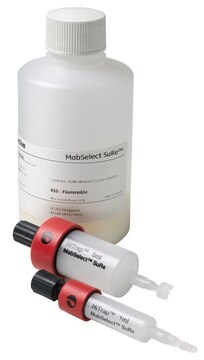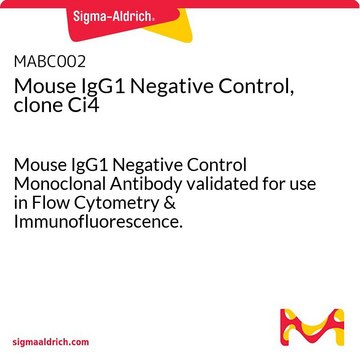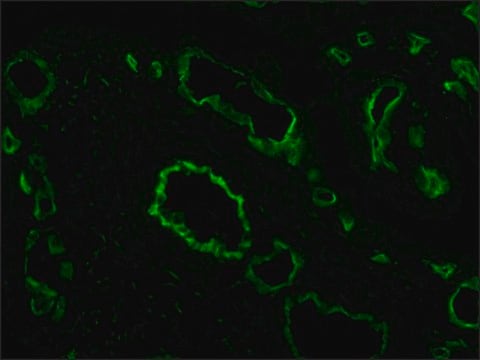MABC006
Mouse IgG2b Negative Control, clone GC198
Mouse IgG2b Negative Control Monoclonal Antibody validated for use in Flow Cytometry & Immunofluorescence.
About This Item
Empfohlene Produkte
Biologische Quelle
mouse
Qualitätsniveau
Antikörperform
purified immunoglobulin
Klon
GC198, monoclonal
Hersteller/Markenname
Chemicon®
Konzentration
0.5 mg/mL
Methode(n)
flow cytometry: suitable
immunofluorescence: suitable
Isotyp
IgG2b
Versandbedingung
wet ice
Posttranslationale Modifikation Target
unmodified
Spezifität
Immunogen
Anwendung
Sekundär- & Kontrollantikörper
Epitop-Tags & allgemeine Anwendung
Isotypspezifische Kontrollantikörper
SUGGESTED USAGE
The control antibody should be diluted to the same concentration as the test antibody, and equivalent volumes used.
Verlinkung
Physikalische Form
Lagerung und Haltbarkeit
WARNING: The monoclonal reagent solution contains 0.1% sodium azide as a preservative. Due to potential hazards arising from the build up of this material in pipes, spent reagent should be disposed of with liberal volumes of water.
Rechtliche Hinweise
Haftungsausschluss
Signalwort
Warning
H-Sätze
P-Sätze
Gefahreneinstufungen
Met. Corr. 1
Lagerklassenschlüssel
8B - Non-combustible corrosive hazardous materials
WGK
WGK 2
Flammpunkt (°F)
Not applicable
Flammpunkt (°C)
Not applicable
Analysenzertifikate (COA)
Suchen Sie nach Analysenzertifikate (COA), indem Sie die Lot-/Chargennummer des Produkts eingeben. Lot- und Chargennummern sind auf dem Produktetikett hinter den Wörtern ‘Lot’ oder ‘Batch’ (Lot oder Charge) zu finden.
Besitzen Sie dieses Produkt bereits?
In der Dokumentenbibliothek finden Sie die Dokumentation zu den Produkten, die Sie kürzlich erworben haben.
Unser Team von Wissenschaftlern verfügt über Erfahrung in allen Forschungsbereichen einschließlich Life Science, Materialwissenschaften, chemischer Synthese, Chromatographie, Analytik und vielen mehr..
Setzen Sie sich mit dem technischen Dienst in Verbindung.

![3-Aminoimidazo[1,2-a]pyridin 97%](/deepweb/assets/sigmaaldrich/product/structures/177/879/133fd1ee-499a-4242-9d3c-406e87ce1d6c/640/133fd1ee-499a-4242-9d3c-406e87ce1d6c.png)







